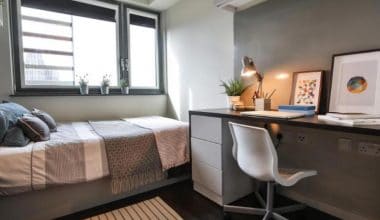Around the world, solar electricity has been able to sustain entire towns on its own. That being said, you can certainly run your house solely on solar power.
With the ability to power everything from pocket calculators to large cities, it is the most versatile power source the world has ever seen.
And it’s clear that a single house can be powered by solar when you take into account that enough sunshine strikes the Earth every hour to power everyone on the planet for a complete year.
Why wouldn’t anybody want to turn their ancestral homestead into a solar-powered machine? It seems like the recipe for success, doesn’t it? Going solar can have a number of very significant advantages.
However, exercise caution: Before you sever the connection with your local utility supplier, there are many things to consider.
After the initial cost of system setup and ongoing maintenance, solar electricity is free.
Solar energy is efficient, yet various experts disagree on how efficient it is. Not to mention that solar energy produces no pollution, which is important to many of us in this day of climate change.
The more important question, however, is “how to run your house solely on solar power”. We have compiled everything you need to know in this article.
Table of contents
What is the Solar Panel System Size?
Appropriate system size is the first, and most likely, most significant, need for using solar power to power your entire home.
Your home won’t have enough power if you have fewer panels than what’s needed, and you’ll spend more money if you have more panels than what’s needed.
So, a system design is used to determine the system size. Your system design determines how many solar panels you will require based on your past energy consumption.
Therefore, to get a ballpark idea of how many solar panels you could require, utilize a solar calculator. This will also help you estimate the possible savings that your system might produce.
Read this: What Is Modal Fabric and Is It Eco-friendly?
Can I Run My Whole House on Solar Energy?
You can certainly run an entire house entirely on solar energy with a sophisticated solar energy system that includes power storage.
The cost of powering a whole house entirely with solar energy has never been lower thanks to today’s highly efficient solar panels and solar batteries.
Since the general introduction of solar energy use for home and commercial purposes twenty years ago, the costs of solar panel systems and installation have continued to decline.
So, this is true even when utility company incentives, state and local government tax breaks and rebates, and federal tax credits are decreasing year.
The significant decline in solar costs can be attributed in part to the growing use of solar energy on a national and international level as well as to the quick development of solar energy system technology.
Furthermore, start with these initial fundamental assessments to ascertain the viability and cost-effectiveness of running a totally solar-powered house:
Calculate how much electricity you use per month.
To power your entire home with solar energy, first calculate how much solar energy you will need to create. You’ll need to know your typical monthly electricity consumption in order to do that.
Also, your solar contractor will be able to determine how much electricity your panels must produce each month to power your entire house thanks to this.
Naturally, variations in monthly usage and solar power generation potential are to be expected throughout the year.
Modern household solar battery storage systems have reserve capacity that can help you guarantee a consistent power supply for your house.
The extra power your solar panels generate on longer, sunnier days can be stored in your solar batteries for use whenever you need it during less sunny times.
Solar batteries make sure you have all the power you need to run your complete house during times when there isn’t as much direct, bright sunlight. Without them, the system will automatically start drawing electricity from the public grid.
Also, read this: Best Grants for Loft Insulation in UK | 2024 Requirements
Evaluate your climate region’s solar energy production capacity.
How much solar energy you may anticipate to generate to power your entire house year-round depends entirely on the environment where you reside.
Assess whether the environment in your area can support the production of solar energy sufficient to power your entire home on a continual basis.
It might be more difficult for homeowners to run a house completely on solar power throughout the winter for those who live in colder, cloudier climates, such those near the northwest Pacific coast.
People who live in southern states might not experience a cloudy day for weeks, while residents might not see direct sunlight for weeks at a time.
These climate variations, in addition to elements unique to your house and way of life, can mean the difference between being able to run your entire household completely off the public power grid and still need at least some electricity from your utility provider.
Assess your solar production environment based on your home’s surroundings.
Take into account the height of the surrounding homes and other structures, as well as the quantity and vicinity of huge trees that are growing around and near your property.
Large trees and tall buildings that are close enough to your house to shade your roof heavily for more than a third of the day can significantly lower the efficiency of your solar energy system.
Check this: 10 Best Grants For Heat Pumps In UK | 2024 Requirements
How to Run Your Whole House on Solar?
The good news is that you will be able to run your home more easily than ever before with solar energy because none of the aforementioned worries will prevent you from doing so.
Once more, determining how many panels your home will require for sufficient energy output and storage is crucial to switching to solar power exclusively.
Based on a number of factors, some highly qualified expert solar energy estimators will calculate the number of solar panels needed to power an off-grid home.
These include your area, the size of your home, the size of your family, the normal historical usage, and, if relevant, the anticipated future growth.
Using solar power to power your home requires a few important actions and considerations.
Here is a road map to help you through the procedure on how to run your house solely on solar power:
Assess Your Energy Needs
Start by assessing the energy usage in your home. To determine your typical monthly usage, review your electricity invoices.
Take into account the number of people living there, the appliances, the HVAC system, and any other electrical equipment you use on a daily basis.
You can use this assessment to find out how big and powerful of a solar panel system you’ll need to suit your energy needs.
In addition, this is one of the procedure of running your house solely on solar power
Also, check this: 15 Best Mechanical Engineering Colleges in Pune | Ranking
Evaluate Solar Potential
Find out your property’s solar potential. Evaluate the amount of sunshine your site receives all year round, taking into account things like building shadows from surrounding trees or structures.
Your roof or a portion of your property should ideally receive as much solar exposure as possible. Look into ideas like tree cutting or different mounting techniques if there are shading problems.
Seek Professional Advice
To determine whether a solar panel system is feasible for your particular situation, speak with solar energy experts or companies.
In addition to analyzing your energy requirements and recommending system size, equipment, and installation, they may perform a site inspection. Seeking a professional advice is one of the procedure of running your house solely on solar power
Select Solar Panels
Select premium solar panels that fit your needs and price range. Take into account elements like effectiveness, robustness, guarantee, and certifications.
Typical alternatives include thin-film, polycrystalline, and monocrystalline solar panels. Examine many brands and contrast their dependability and performance.
Also, this is one of the process of running your house solely on solar power
See also: Study in Germany : Master’s Degree In Engineering
Choose An Inverter
Choose an inverter that is appropriate for the size and kind of solar panel system you have. Also, it is one of the process of running your house solely on solar power. The DC electricity produced by the solar panels is converted into AC electricity for your home by inverters.
Power optimizers, microinverters, and string inverters are among them. Regarding installation requirements, system performance, and monitoring, each has pros and downsides.
Determine Energy Storage Needs
Make a decision regarding the integration of energy storage into your solar system.
With energy storage devices, usually batteries, you can store extra solar energy produced during the day to use at night or during times when the sun isn’t shining as much.
They can improve your energy independence and offer a reliable power source. Take into account elements like battery capacity, cycle life, depth of discharge, and solar system compatibility.
Obtain Permits And Approvals
Verify local laws and secure the required approvals and permits before installing solar panels.
The location of panels, electrical connections, and grid integration may all be subject to particular regulations or limitations in some areas.
Related post: 20 Top Electrical Engineering Schools In USA | Ranking
Install the System
Hire experts or licensed installers to complete the installation. They will guarantee that the panels are installed, wired, and integrated into the electrical system of your house correctly.
During installation, it is imperative to adhere to local electrical codes and safety procedures.
Connect To The Grid Or Opt For Off-Grid
Choose between using your solar system entirely off-grid or connected to the electrical grid. Net metering, in which extra solar energy is fed back into the grid and you get credits, is made possible via grid connection.
If you decide to live off the grid, you will need a higher energy storage capacity to supply your home with electricity when solar output isn’t as high.
In addition, this is one of the procedure to run your house solely on solar power.
Monitor And Maintain
Keep an eye on your solar panel system’s functioning and take care of any necessary maintenance on a regular basis. Maintain the panels’ optimal performance, cleanliness, and lack of dirt.
Also, refer to the manufacturer’s maintenance requirements and think about scheduling routine expert checks.
Read also: 10 Government Grants For Solar Panels In the UK
What are the Factors that Impact The Ability to Reach 100% Coverage with Solar Energy?
How Much Energy You Use
In order to completely satisfy your house’s energy requirements, your solar installation must first ascertain the average amount of energy consumed by your house.
Examining your historical electricity usage—which is included in your electricity bills—is the most popular method.
It will go beyond simply reading the most recent bill, though. When creating a system that satisfies all of your energy requirements, a solar installation must consider a great deal of elements.
You’ll probably use different amounts of electricity in different months and during different seasons.
Spring and fall milder temperatures could result in cheaper electricity costs than summer’s scorching heat and running air conditioners nonstop. Wintertime electricity usage may increase due to longer days and more time spent inside.
Therefore, for a complete understanding of the size of the system you will require, your solar installer must average out how much electricity you use on a regular basis.
The local climate and weather are additional variables to consider. A solar system in Florida will generate less electricity annually than one in Washington, even though solar energy has shown to be viable in even the most overcast or rainy of conditions.
Your system will produce a lot more electricity in the summer than it will in the winter, no matter where you reside.
Also, installers will use local average weather patterns to determine an accurate estimate of the amount of electricity you can reasonably produce year-round.
Your Available Space
Installing solar panels in a bright, sunny location that won’t obstruct your daily activities is necessary.
The roof is often the most sensible location for solar panels on a property, but if ground-mounted solar systems are more appropriate for your needs, solar panels can also be erected on land.
Roof-Mounted You’ll need the area necessary to install a solar system that can supply all of the electricity needed for your home. A 330W solar panel occupies around 19.5 square feet.
A normal home’s solar system capacity will be between 5 and 20 kW. Therefore, to build a system that will suit your needs, you’ll need between 312 and 1,189 square feet of sunny space with few obstacles.
Roofs are not made equally. Roofs that face northward receive less sunlight throughout the day, so you might need to install more panels to make up for the production loss.
It could be necessary to prune or remove any trees that provide shade to your roof throughout the day. Additional hindrances such as adjacent structures, chimneys, and exhaust fans may further affect output.
The ability to tilt and position a ground-mounted system to maximize solar production is one of its key advantages. A roof mount might not be able to accomplish this.
Related post: 15 Best Solar Companies Washington State Careers, Location
Deciding Between Off-Grid vs Grid-Tied
You can use an off-grid or grid-tied solar system to power your home entirely with solar energy if that is your objective. What happens to your extra electricity and how you get electricity when your system isn’t producing power are the differences between these two.
You will still need to use your system even though it won’t produce as much electricity on cloudy or wet days or at night. So, by producing more electricity during the sunny hours, solar power may still give you electricity during these times.
Furthermore, if you choose a grid-tied system, the extra electricity is either transmitted to the electrical grid in exchange for a credit, or it is stored in batteries in the case of off-grid systems.
A solar system that is fully independent of the electric utility is known as an off-grid system. This implies that the utility won’t be able to supply power to your house.
Going off the grid, meanwhile, can be costly and call for certain adjustments to one’s way of life.
Even though battery prices are still dropping, it can add up to buy enough to last you through a few cloudy days and dark nights. You will need to be aware of the difference between the amount of electricity your system can store and the amount you use.
You won’t need to buy batteries to store surplus energy if your system is grid-tied, allowing you to produce all the electricity your house needs.
FAQs – Run Your House Solely on Solar Power
A house can be powered exclusively by solar energy. Going totally off the grid, however, necessitates a significant time and money commitment. You’ll need more solar panels the more electricity you consume.
Weather dependence is the biggest disadvantage of solar energy since cloudy, gloomy, and wet weather prevents the panels from gathering energy. The high upfront cost is another significant drawback, particularly if you’re going fully off the grid.
Although solar energy is the least priced renewable energy source, it is still four times more expensive than conventional energy sources.
Calculating your solar panel requirements based on the location and monthly cost of your electricity bill is simpler.
According to general criteria, a 1,000 square foot home with an average monthly power expenditure of $50–60 should have at least a 5-kilowatt system installed by the homeowners. A 5,000-watt solar power system will set you back about $15,000.
This is because the average cost per watt in the United States is $3. This ignores crucial elements like your unique location (and weather), the orientation of your roof, the kind of home you own, and the state and federal funding that are available.
Investing in solar power is important because it can reduce or eliminate the need for fossil fuels to produce electricity and power our homes.
Conclusion
Solar energy is an amazing source of power. The sun is the source of energy for everything on Earth, including a single house. All you have to do is make sure your system is installed and sized correctly to accomplish that.
In the past, homes could not have been successfully and efficiently powered through the evenings or darker days due to the intermittent nature of solar electricity.
Customers may now select from a variety of backup systems that guarantee that a portion of the house or the entire structure can function solely on solar power thanks to advancements in smart technologies and sophisticated batteries.
In the end, it’s up to you how and to what extent you want to rely on solar and grid power to power your appliances.





